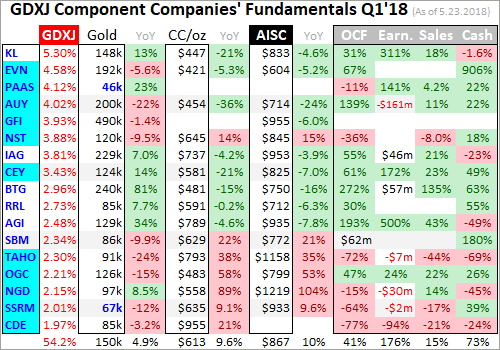By Adam Hamilton – Zeal Intelligence
The junior gold miners have largely been shunned over the past year or so, condemned to listlessly drift near lows. Their stock prices have suffered serious collateral damage from stubbornly-bearish gold sentiment. But they are faring much better under the hood than their battered visages suggest, with their latest quarterly results revealing strong fundamentals. Juniors are ready to soar when gold sentiment turns.
Four times a year publicly-traded companies release treasure troves of valuable information in the form of quarterly reports. Companies trading in the States are required to file 10-Qs with the US Securities and Exchange Commission by 45 calendar days after quarter-ends. Canadian companies have similar requirements. In other countries with half-year reporting, many companies still partially report quarterly.
The definitive list of elite “junior” gold stocks to analyze comes from the world’s most-popular junior-gold-stock investment vehicle. This week the GDXJ VanEck Vectors Junior Gold Miners ETF reported $4.6b in net assets. Among all gold-stock ETFs, that was second only to GDX’s $7.6b. That is GDXJ’s big-brother ETF that includes larger major gold miners. GDXJ’s popularity testifies to the great allure of juniors.
Unfortunately this fame created serious problems for GDXJ over the past couple years, resulting in a major mission change. This ETF is quite literally the victim of its own success. GDXJ grew so large in the first half of 2016 as gold stocks soared in a massive upleg that it risked running afoul of Canadian securities laws. And most of the world’s smaller gold miners and explorers trade on Canadian stock exchanges.
Since Canada is the center of the junior-gold universe, any ETF seeking to own this sector will have to be heavily invested there. Since Canada is the center of the junior-gold universe, any ETF seeking to own this sector will have to be heavily invested there.
But once any investor including an ETF buys up a 20%+ stake in any Canadian stock, it is legally deemed to be a takeover offer that must be extended to all shareholders! As capital flooded into GDXJ in 2016 to gain junior-gold exposure, its ownership in smaller components soared near 20%.
Obviously hundreds of thousands of investors buying shares in an ETF have no intention of taking over gold-mining companies, no matter how big their collective stakes. That’s a totally-different scenario than a single corporate investor buying 20%+. GDXJ’s managers should’ve lobbied Canadian regulators and lawmakers to exempt ETFs from that 20% takeover rule. But instead they chose an inferior, easier fix.
Since GDXJ’s issuer controls the junior-gold-stock index underlying its ETF, it simply chose to unilaterally redefine what junior gold miners are. It rejiggered its index to fill GDXJ’s ranks with larger intermediate gold miners, while greatly demoting true smaller junior gold miners in terms of their ETF weightings. This controversial move defying many decades of convention was done stealthily behind the scenes to avoid outrage.
There’s no formal definition of a junior gold miner, which gives cover to GDXJ’s managers pushing the limits. Major gold miners are generally those that produce over 1m ounces of gold annually. For decades juniors were considered to be sub-200k-ounce producers. So 300k ounces per year is a very-generous threshold. Anything between 300k to 1m ounces annually is in the mid-tier realm, where GDXJ now traffics.
That high 300k-ounce-per-year junior cutoff translates into 75k ounces per quarter. Following the end of the gold miners’ Q1’18 earnings season in mid-May, I dug into the top 34 GDXJ components’ results. That’s just an arbitrary number that fits neatly into the tables below. Although GDXJ included a staggering 73 component stocks in mid-May, the top 34 accounted for a commanding 80.1% of its total weighting.
Out of these top 34 GDXJ companies, only 5 primary gold miners met that sub-75k-ounces-per-quarter qualification to be a junior gold miner! Their quarterly production is highlighted in blue below, and they collectively accounted for just 10.3% of GDXJ’s total weighting. But even that is really overstated, as 3 of these are long-time traditional major silver miners that are increasingly diversifying into gold in recent years.
GDXJ is inarguably now a pure mid-tier gold-miner ETF. That would be great if GDXJ was advertised as such. But it’s very misleading if investors still believe this dominant “Junior Gold Miners ETF” still gives exposure to junior gold miners. I suspect the vast majority of GDXJ shareholders have no idea just how radically its holdings have changed since early 2016, and how much it has strayed from its original mission.
I’ve been doing these deep quarterly dives into GDXJ’s top components for years now. In Q1’18, fully 30 of the top 34 GDXJ components were also GDX components! These ETFs are separate, a “Gold Miners ETF” and a “Junior Gold Miners ETF”. So there’s no reason for them to own many of the same companies. In the tables below I highlighted the symbols of rare GDXJ components not also in GDX in yellow.
These 30 GDX components accounted for 75.0% of GDXJ’s total weighting, not just its top 34. They also represented 31.4% of GDX’s total weighting. So 3/4ths of this “Junior Gold Miners ETF” is made up of nearly a third of the major “Gold Miners ETF”! These GDXJ components in GDX start at the 12th-highest weighting in that latter larger ETF and extend down to 45th. Do investors know GDXJ is mostly GDX gold stocks?
Fully 11 of GDXJ’s top 17 components weren’t even in this ETF a year ago in Q1’17. They alone now account for 34.6% of its total weighting. 16 of the top 34 are new, or 43.4% of the total. In the tables below, I highlighted the symbols of companies that weren’t in GDXJ a year ago in light blue. GDXJ has changed radically, and analyzing its top components’ Q1’18 results largely devoid of …read more
From:: Mining.com

